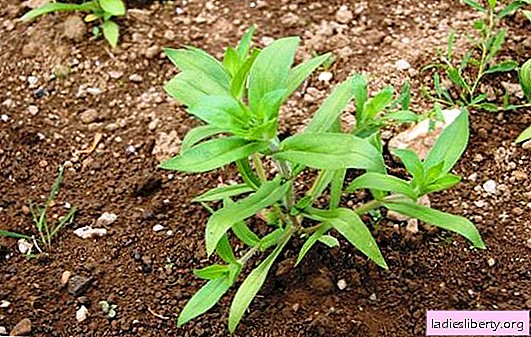
Some gardeners mistakenly believe that phlox do not need care and grow like a weed. The plant is really hardy, easily tolerates drought and lack of additional nutrition, but in such conditions it quickly dies. Special care for the plant should be in the fall, when phlox is planted.
Features autumn planting phlox: when to conduct?
Experienced gardeners plant phlox not only in spring, but also in autumn. As a rule, varieties of medium and early flowering periods are planted during this period. The timing of the work depends on climatic conditions, but no later than September. At this point, the plant already has regeneration buds. If the weather allows, then planting and transplanting can be extended until the beginning of October, but the end of all work should be no later than the end of the month. Later planting leads to the death of the bush.
After planting, the soil must be mulched, which accelerates the process of rooting phlox in a new place. It is noted that those seedlings that have preserved leaf cover are best rooted. Overripe sawdust and peat are used as mulch.
Autumn planting of phlox has its own advantage, which is not present during spring work. The fact is that during the autumn transplant, the plant fully adapts and takes root in a new place, and next season the bush begins to bloom. Planting phlox in the spring does not give such results, the seedling needs time to adapt, and flowering does not begin this season.
How to choose planting material
For autumn planting, large delenki are most suitable, which are easier to root and tolerate winter well. Also during this period, bushes that grew during spring cuttings are planted in a permanent place. When buying new planting material, you should pay attention to the following factors:
• good plot has more than two thick stems;
• large buds of renewal are noticeable near the roots;
• the skin on the shoots is quite dense, coarsened;
• earthball and roots in the wet state.

Choosing the right material for planting, phlox shoots are cut at a height of about 25 cm from the base. Sapling roots also need to be shortened by a third. If the seedling is transplanted with an earthen lump, then only its top is cut off, trying to leave a few leaves.
Suitable place for planting phlox in the fall
Plants are undemanding for maintenance, but lush flowering can be seen only in well-lit areas. In partial shade, the flowers will be smaller, but the flowering period will stretch. The optimal place for planting phlox is a sparse shadow. In the southern regions, it is advisable to shade plants in the midday heat.
Phlox grows well on any soil, but it is better to plant a flower in a loose, moderately nutritious and moist soil. Autumn planting of phloxes in the lowland is prohibited, since an ice crust appears on the surface of the soil. This adversely affects the condition of the plant.
Soil preparation for phlox planting in the fall is carried out in advance, at least 14 days in advance. The site is well dug up, cleared of weeds. The poor in composition of the earth is enriched with humus, peat and sand. Under digging make mineral fertilizers.
The root system of phlox is powerful, so digging is done on two bayonet shovels. The bulk of the roots lies at a depth of about 30 cm.
Autumn phlox planting in the ground, photo
After preparing the soil and seedlings, they begin to plant. Landing pits are made quite wide and deep. The depth should be such that the upper part of the root coma is not less than 5 cm below the ground level. A higher autumn planting leads to freezing of the plant in winter, and too deep slows down the development of phlox.

Immediately before planting, the wells are well watered and drained. A layer of fertile soil, humus and fertilizers is poured over the drainage. Then establish a seedling and sprinkle with earth. In water for watering the plant, you can add drugs to accelerate the formation of roots, for example, "Kornevin."
Advice! In autumn, when planting phloxes, do not add nitrogen fertilizers to the wells, it is better to leave them for spring use. Wells are seasoned only with phosphate and potassium complexes.
Preparing phlox for the winter
Phlox refers to frost-resistant plants, but you should not neglect autumn pruning. Without it, a flower can die. Why are phlox pruned?
• Pruning protects the plant from fungal diseases;
• Facilitates the process of mulching and care;
• Allows you to get a compact bush next spring;
• Allows the plant to accumulate enough nutrients in the root system;
• Protects the plant from freezing in the cold winter.
Phlox pruning is carried out in the fall, after landing or transplanting to a new place. Bushes that have not undergone transplanting also need pruning. You should not hang out with her. Pruning must be completed before the onset of frost. As a rule, it is carried out from September to the end of October.
Trimming is carried out in several ways:
• The aerial part of the plant is cut off at the level of 5 cm from the soil surface. Such pruning allows you to retain snow and protects the plant from frost.
• The second type of pruning is used to protect the plant from fungal diseases. At the same time, all shoots are cut flush with the soil.
In addition to pruning, phlox feed and mulch. Autumn feeding of phlox is carried out on frozen soil. Apply mineral complexes mixed with ash, which prevents the appearance of pests.
Winter mulching is carried out 10 days after planting. To this end, peat, compost, fallen leaves and humus are used. Such a mulch in combination with pruning allows you to grow a healthy bush that will delight you with bright flowering in spring.
Problems When Growing Phlox
1. Phlox is often affected by powdery mildew. This is due to improper care or an inappropriate place to grow. In the shade, the flower is most vulnerable.
2. Phlox nematode leads to the death of the plant. It is not treatable, the bush is uprooted and removed from the site. Signs of the disease are manifested by pallor and wilting of the top of the shoots, while the leaves are thinning.
3. Great damage to plantings is caused by slugs. Lime and ash, which is sprinkled on the paths and aisles, will help get rid of them. Timely loosening of the soil also has a detrimental effect on slugs.
Phloxes are perennial unpretentious plants that serve as a decoration for a flower bed. They have gained popularity among gardeners due to their frost resistance, unpretentious care and brightness of colors. Phloxes are used in modern design, they are well written off to the interior of any garden. When choosing plants, you need to consider the timing of flowering, the color of the petals and the height of the bush. Choosing the right phlox, you can achieve continuous flowering during the season. Having mastered the basic rules for caring for the bush, planting it will not cause trouble. And the advice of experienced gardeners will help to grow a healthy plant that successfully wintered even in the most severe conditions.











